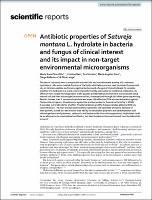Por favor, use este identificador para citar o enlazar este ítem:
https://repositorio.usj.es/handle/123456789/1011
Registro completo de metadatos
| Campo DC | Valor | Lengua/Idioma |
|---|---|---|
| dc.contributor.author | Pino Otín, Rosa | - |
| dc.contributor.author | Gan, Cristina | - |
| dc.contributor.author | Terrado, Eva María | - |
| dc.contributor.author | Sanz, M. Ángeles | - |
| dc.contributor.author | Ballestero Fernández, Diego | - |
| dc.contributor.author | Langa Morales, Elisa | - |
| dc.date.accessioned | 2023-10-24T12:31:27Z | - |
| dc.date.available | 2023-10-24T12:31:27Z | - |
| dc.date.issued | 2022-11-02 | - |
| dc.identifier.citation | Pino-Otín, M.R., Gan, C., Terrado, E. et al. Antibiotic properties of Satureja montana L. hydrolate in bacteria and fungus of clinical interest and its impact in non-target environmental microorganisms. Sci Rep 12, 18460 (2022). https://doi.org/10.1038/s41598-022-22419-2 | en_US |
| dc.identifier.issn | 2045-2322 | en_US |
| dc.identifier.uri | https://repositorio.usj.es/handle/123456789/1011 | - |
| dc.description.abstract | The aim of this study was to analyse the microbicidal and microbiostatic activity of S. montana hydrolate L., the water-soluble fraction of the hydro-distillation process used to obtain the essential oil, on 14 Gram-positive and Gram-negative bacteria and a fungus of clinical interest. To consider whether this hydrolate is a more environmentally friendly alternative to traditional antibiotics, its effect on non-target microorganisms in the aquatic and terrestrial environment was analysed using natural soil and river microorganism communities, characterized through 16S rRNA gene sequencing. Results showed that S. montana hydrolate was especially effective (25% v/v concentration) against Pasteurella aerogenes, Streptococcus agalactiae and Acinetobacter baumannii (priority 1, WHO). It was also a microbicide for a further 7 bacterial strains and the fungus Candida albicans (50% v/v concentration). The river and soil communities exposed to the hydrolate showed a decrease in their growth, as well as a decrease in their ability to metabolize polymers and carbohydrates (soil microorganisms) and polymers, carboxylic and ketone acids (river microorganisms). Hydrolates could be an alternative to conventional antibiotics, but their impact on the environment must be taken into account. | en_US |
| dc.format.extent | 17 p. | en_US |
| dc.format.mimetype | application/pdf | en_US |
| dc.language.iso | eng | en_US |
| dc.publisher | Nature Portfolio | en_US |
| dc.relation | The authors thank the financial support of Gobierno de Aragon: Departamento de Ciencia, Universidad y Sociedad del Conocimiento (Group E39_20R), Catedra NOVALTIA, Universidad San Jorge, and Foundation Sabadell for the research scholarship. This study complies with local and national guidelines. | en_US |
| dc.rights | Atribución 4.0 Internacional | * |
| dc.rights.uri | http://creativecommons.org/licenses/by/4.0/ | * |
| dc.subject | Origanum-vulgare l. | en_US |
| dc.subject | Escherichia-coli o157/h7 | en_US |
| dc.subject | Personal care products | en_US |
| dc.subject | Water treatment plants | en_US |
| dc.subject | In-vitro activity | en_US |
| dc.subject | Essential oil | en_US |
| dc.subject | Antimicrobial activity | en_US |
| dc.subject | Chemical-composition | en_US |
| dc.subject | Candida-albicans | en_US |
| dc.subject | Artemisia-absinthium | en_US |
| dc.title | Antibiotic properties of Satureja montana L. hydrolate in bacteria and fungus of clinical interest and its impact in non-target environmental microorganisms | en_US |
| dc.type | info:eu-repo/semantics/article | en_US |
| dc.identifier.doi | https://doi.org/10.1038/s41598-022-22419-2 | en_US |
| dc.rights.accessrights | info:eu-repo/semantics/openAccess | en_US |
| Aparece en las colecciones: | Artículos de revistas | |
Ficheros en este ítem:
| Fichero | Descripción | Tamaño | Formato | |
|---|---|---|---|---|
| Antibiotic properties of Satureja montana L. hydrolate in bacteria and fungus.pdf | 2,09 MB | Adobe PDF |  Visualizar/Abrir |
Este ítem está sujeto a una licencia Creative Commons Licencia Creative Commons

